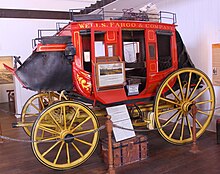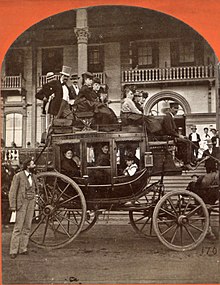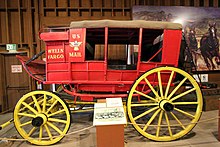

The Concord coach was an American horse-drawn coach, often used as stagecoaches, mailcoaches, and hotel coaches. The term was first used for the coaches built by coach-builder J. Stephen Abbot and wheelwright Lewis Downing of the Abbot-Downing Company in Concord, New Hampshire, but later to be sometimes used generically. Like their predecessors, the Concords employed a style of suspension and construction particularly suited to North America's early 19th century roads. Leather thoroughbraces suspend passengers who are in constant motion while the coach is moving. The swaying is accepted by passengers for the shock absorbing action of the leather straps and for the way the special motion eases the coach over very rough patches of roadway. This suspension, which was developed by Philip de Chiese in the 17th century, was long replaced by steel springs in England.
The coaches developed out of earlier models, such as the “melon-shaped” coach illustrated by Captain Basil Hall, and was probably first built in this final form in Upstate New York, and were often known as “Troy coaches” or “Albany coaches”.
The Abbot-Downing Company, however, continued making these coaches for over 70 years, well after most their competitors, and the name became used as a generic term.
They were high-end, expensive vehicles; the cost was justified by long service life. The thoroughbrace suspension reduced stresses on the structure and improved passenger comfort.
Railroads began replacing stagecoaches in the middle of the 19th century, but Concord coaches remained in commercial use into the 20th century and continue to be used in parades and for publicity purposes by Wells Fargo Bank.
Description

- The three longitudinal perches,
- the front transom supporting the metal uprights,
- the front axle with its link for the pole.
- Brake levers on the outside edge either side
Concord coaches were made from wood with iron fittings. European coaches—constructed for smooth roads—could not withstand the rough American roads without breakage. Instead of using metal springs, the Concord coach body was suspended by strong leather straps called thoroughbraces, which enabled the vehicle to be constructed lighter than typical European coaches. A larger Concord might weigh 2,500 pounds (1,100 kg) and could stand over 9 feet (2.7 m) tall.
Inside there were three bench seats which accommodated 6, 9 or 12 passengers, depending on model. Bench seats at the front and back of the coach had limited headroom. Passengers on the center bench had no backrest but steadied themselves with a broad leather harness suspended across the coach by straps from the roof. Another six passengers could travel on the roof.
There was an external luggage compartment or boot at the back of the coach and another boot for valuables below the driver's seat at the front. The rear wheels had brake blocks which acted on the iron tires, controlled by the driver with a foot lever to his right at the side of his footboard.
Photo gallery
- A Concord coach in Hadley Farm Museum, Hadley, Massachusetts
-
-
-
-
Horses
The leading horses are known as the lead horses. The wheel horses or wheelers are the back pair nearest the coach's wheels. The number of horses, referred to as a team, could be 2, 4, 6, or even more. The amount of horses used in a hitch depended upon the condition of the roads, the terrain, and the weight of the load.
Operation

It is not possible to guide a Concord coach with European-style precision. The Concord body continuously shifts. The driver or coachman has to sit slightly askew and brace himself with the aid of a steeply angled footboard. He cannot keep his reins in a steady contact with the horses' mouths. He has to bend his arms and elbows to constantly compensate, and his body always leans slightly forward. He holds his left reins in his left hand and his right reins — separated by his middle finger — in his right hand and not all in one hand like a European could. It is easy to slacken an individual rein but much more difficult to shorten it. His right hand also has to control his whip used on the wheel horses. If obliged to make his right hand free, then he must lay all the right hand reins in his left hand unseparated.
The horses were harnessed very loosely by European standards because without proper roads the horses had to be allowed to avoid their particular obstacles. The Concord pole, though mounted to allow far more play, moved less.
The result was the coach's direction was straighter than with a European coach, it did not respond to every irregularity in the road.

Australia and New Zealand
Concord-style stagecoaches were used in Australia and New Zealand; see Cobb & Co and Cobb & Co (New Zealand)
Abbot-Downing wagon
Main article: Abbot-Downing CompanyConcord coaches were expensive. Abbot-Downing also supplied a much simpler, lighter, and less expensive vehicle which they named Overland wagon and later Western passenger wagon.
See also
- New Hampshire Historical Marker No. 128: The Concord Coach
References
- ^ Sallmann, Robert (Spring 1979). Ryder, Thomas (ed.). "Coaching in the "Old" and "New" World". The Carriage Journal. 16 (4). Carriage Association of America: 204–206. ISSN 0008-6916 – via Google Books.
- "1891 Abbot Downing Concord Coach - The Henry Ford". The Henry Ford. Retrieved March 8, 2019.
- Groves, Melody (2014). Butterfield's Byway: America's First Overland Mail Route Across the West. The History Press. ISBN 9781625850379. LCCN 2014014195.
- Wheeling, Ken (October 2005). Ryder, Jill M. (ed.). "They Called Them Mudders". The Carriage Journal. 43 (5). Carriage Association of America: 236–239. ISSN 0008-6916 – via Google Books.
External links
- Abbot-Downing Historical Society
- Concord Coach #472. This is the 9 feet high 12 interior passenger version scroll down
- Smithsonian video about US coaching



